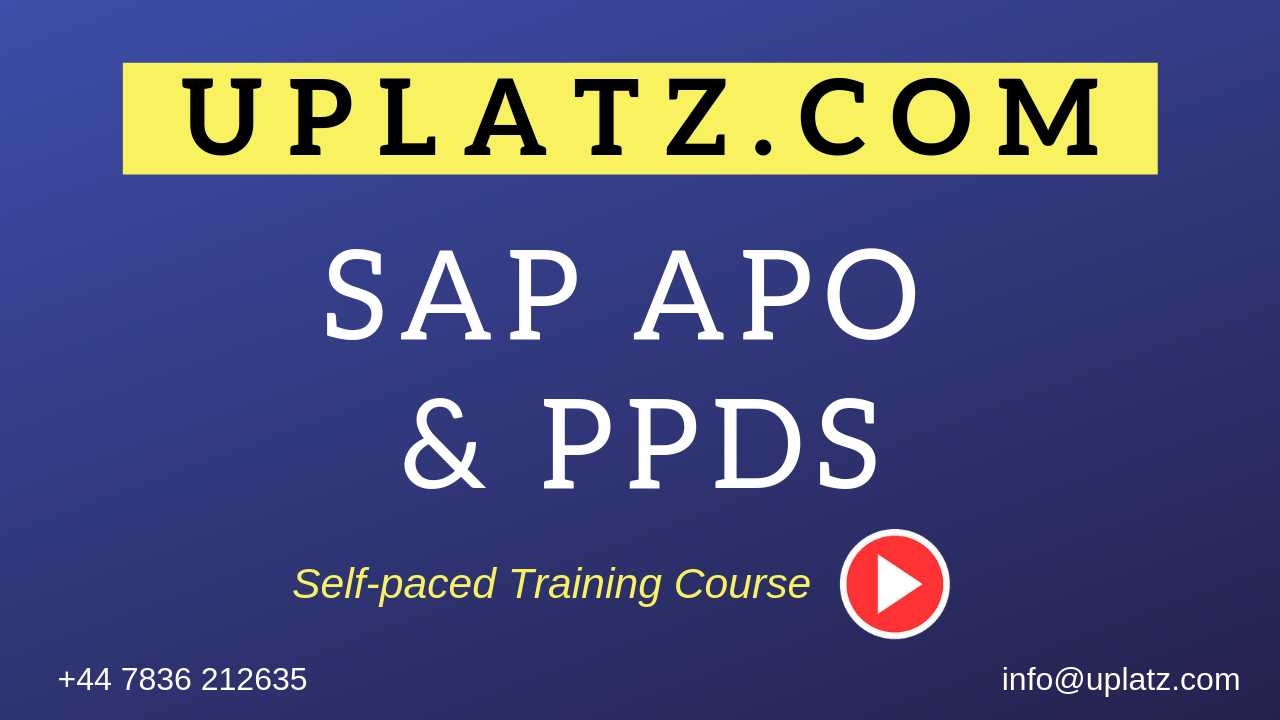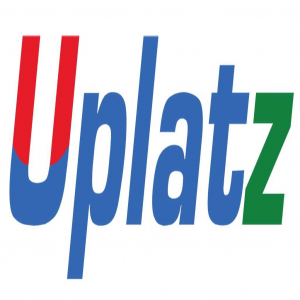SAP APO (DP and SNP)

Get in touch with us Phone: +44 7836 212635
Whats App: + 44 7836 212635
Website: https://www.uplatz.com
Browse www.uplatz.com to see more courses.
Uplatz.com is a leading Marketplace for IT and Certification courses.
SAP APO (DP and SNP)
MODULE 1 - SAP APO CIF (CORE INTERFACE) TRAINING
RFC Connection
Business System Group
Master Data Overview
Integration Model Master Data
Master Data for Transfer of Data Changes
SAP APO Master Data
Models and Planning Versions
Transaction Data Overview
Integration Model Transaction Data Monitoring
CIF Cockpit, qRFC Alert and Comparisons
Capacity Requirements, Capacity Planning / Optimizer
Exception Processing, Alert Generation
MODULE 2 - DEMAND PLANNING
Introductions, APO Overview
Overview of Demand Planning Concept
Data mart, info-cubes & Demand Planning
Planning area and Planning Books
Macros & Notes
Interactive Planning
Statistical toolbox, Promotions and Life Cycle Planning
Mass Processing and Release of Plans
Exception Processing and Alert Generation
MODULE 3 - SUPPLY NETWORK PLANNING
Overview of Supply Planning Concept
Supply Planning, Interactive Supply Planning, and Integration with other SCM components
Planning Methods: Heuristics, Optimization & CTM
Deployment
Transport Load Builder
Releasing Supply Plans to DP, PPDS, ECC
CIF Core Interface: Introduction to Architecture of Integration
Master Data, Integration to R/3
Planning in ECC - APO with Integration Model Generation
Initial & Change Transfers, Background Jobs
Monitoring & Handling CIF Errors
Comparison & Reconciliation
MODULE 4 – PRODUCTION PLANNING and DETAILED SCHEDULING
Introduction and Course Overview
Introduction
The Role of APO-PP/DS in Supply Chain Planning
Master Data Overview
Demand Management
Planned Independent Requirements and Sales Orders
Make-to-stock production
Make-to-Order Production
Enhancements for Demand Management
Tools and Production Planning
Product View
Product Planning Table
Product Overview
Pegging Overview
Detailed Scheduling Planning Board
Resource Planning Table
PP/DS Optimizer
Production Planning
Prerequisites and Basic Settings
The Planning Process
Heuristics
Steps in Production Planning
Introduction
Net Requirements Calculation and Lot-Size Calculation
Source Determination
PPM/PDS Explosion and Scheduling
Pegging
Setup Times
------------------------------------------------------------------------------------------------------
SAP APO Interview Questions
------------------------------------------------------------------------------------------------------
Q.1. What is SAP APO?
Ans. SAP APO stands for Advanced Planner and Optimizer, which is one area of SCM and application component of MySAP product. It is designed to provide solutions for companies in Demand planning, network design, supply network planning, production planning and global available to promise, transportation and scheduling.
Q.2. How is bank reconciliation handled in SAP?
Ans. The following are the steps for BRS:
Create Bank Master Data - This can be created through T.Code FI01 or you can also create the house bank through IMG/FA/Bank accounting/Bank account
Define House Bank
Set up Bank selection payment programe- IMG/FA/ARAP/BT/AUTOIP/PM/Bank selection for payment prg. setup all co codes for payment transaction - Customer and vendors setup paying co codes for payment transactions setup payment method per country setup payment method per co code for payment transaction setup bank determination for the payment transaction
Q.3. How can a planning version be frozen and unfrozen?
Ans. A Planning Version can be frozen and unfrozen using Function Module /SAPAPO/TS_PAREA_VERSIO_FREEZE so that no further changes to the planning version can be done.
Q.4. What is Release Profile?
Ans. Release Profile is used to release timeseries data from DP to SNP/PPDS. You need to define the DP Planning Area and timeseries key figure the data in which is released and the SNP Category Type (typically FA) to which data is released. You may maintain a Daily Buckets Profile it will define the number of working days (working days determined based on Shipping Calendar maintained for the location master) starting on and from the From Date if released online/ interactively or that many workdays of the planning horizon when release is carried out in the background. The Period Split (blank, 1 and 2) field in the SNP2 tab of location-product master determines how the demand plan is released to SNP from DP (how bucketed data is disaggregated to the workdays).
Q.5. What is the usage of Period Factor?
Ans. Period Factor maintained in the SNP PPM or Transportation Lane determines the Availability Date of a Receipt element within a time bucket (period). The system determines the exact availability date/time of the receipt elements within a period, by adding a time interval (that it gets by multiplying the period factor with the period length) to the start time of the period. You can enter a factor between 0 and 1, where 0 is the start of the period, 0.5 the middle, and 1 the end of the period. When calculating the availability date/time, the system takes into consideration all weekdays, meaning that it does not take into consideration any days that have been defined as non-workdays in the calendars. Period Factor used is .71 = 7x0.71 = 4.97 or 5 days from optimizer of weekly bucket resulting in a Friday. If Period Factor is not maintained in PPM or Transportation Lane then the User Period Factor indicator and the Period Factor value maintained in the Lot Size tab of the location-product combination are used. If this is not maintained a default value of 0.5 is used.
Q.6. What is the shortcut to change location type in APO?
Ans. Report /SAPAPO/CHECK_LOCATION_TYPE can be used to change location type (say from 1001 to 1002 or vice-versa) of existing locations in APO. The table to refer to is /SAPAPO/LOCMAP. SAP does not recommend this process.
Remark: Can you check if this works - cos I think you need to use/SAPAPO/CHANGE_LOCTYPE
Q.7. What determines stock categories displayed in Stock on Hand key figure?
Ans. The categories defined in Category Group ST1 (can be maintained in table /SAPAPO/APOCGC) determine the stock categories that are displayed in the Initial bucket in the Stock on Hand keyfigure. Subsequent buckets are dynamically computed.
Q.8. Do dynamic alerts show up in Alert Monitor?
Ans. Dynamic Alerts do not show up in the stand-alone alert monitor. Network alerts are to show pegging relationships.
Q.9. What is the report to execute MASSD?
Ans. The report for executing MassD in the background job is MASS BACK.
Q.10. How can a transaction be executed even when no authorization?
Ans. SE93 - Transaction code for Transaction Code E.g. CRC1 Create Resource has txn code CRAH. So, if you do not have the authorization to create a resource you can use SE93 and enter txn CRAH and then Test F8 button to go to the txn.
Q.11. How to copy a Process Chain?
Ans. To copy a process chain to another process chain, goto the Process Chain you want to copy and then type copy in the tool tar and hit enter. It will allow you to copy the Process Chain to another Process Chain that can be modified as per the user's requirement, saved, activated and used.
Remark: To copy a process chain to another process chain, goto the Process Chain you want to copy and then type copy in the tool tar also... if you drop down on the toolbar under process chain you have a copy option... but this looks cool :)
Q.12. What is the process to copy planning versions in R/3?
Ans. Use OLIX to first delete previous MRP planning versions. Then use MCB& to create the new MRP planning versions by choosing the appropriate version you want to create as ICO Version. The info structure, in this case, is S094.
Q.13. How to use create a planning book with two tables?
Ans. To use two tables on one screen of Planning Book/Data View - select indicator next to the second-page title and give a name. An additional tab page is displayed in the Planning Book Maintenance wizard to define the key figures for the second table.
Q.14. How do you configure an electronic bank statement?
Ans. Following is the sequence of configuration to be done for Electronic Bank Statement (EBS):
Create Transaction types (which helps you group all the house baks with the same External transaction code).
· Assign them to house banks.
· Create and define posting rule keys.
· Assign them to external transaction codes.
· External transaction codes are bank specific codes for business transactions (which it issues in each EBS) each one for each type of payment. eg. transfer order, foreign transfer, bill of exchange, etc.
· Define posting specification for G/L posting as well as sub-ledger posting
· Define account symbols (which determine the G/L account to be posted to) and assign them to post keys.
Q.15. What is the difference between profit center accounting and Profitability analysis?
Ans. Profit center accounting is basically done for internal controlling purposes. It lets you determine the profit and loss using the cost of sale approach or period accounting approach. Here you can find the profit from an "area of responsibility or person" point of view.this is account-based costing
Whereas in Profitability analysis, market segments based on product, customer, order aor any combination of these are studied to find wots the profit. PA provides information to the marketing,sales and planning department so that they can make decisions. PA has two forms of account-based and CO based.
Q.16. What is the Ranking order in the automatic payment program?
Ans. It’s the priority assigned to each house bank which helps the Automatic Payment program choose the house bank for payment in case there is more than one bank satisfying the payment program.
If a payment program ends up selecting more than one (say 4) bank for payment, the ranking of the banks helps it select one bank from the list of (say 4) selected banks.
------------------------------------------------------------------------------------------------------








